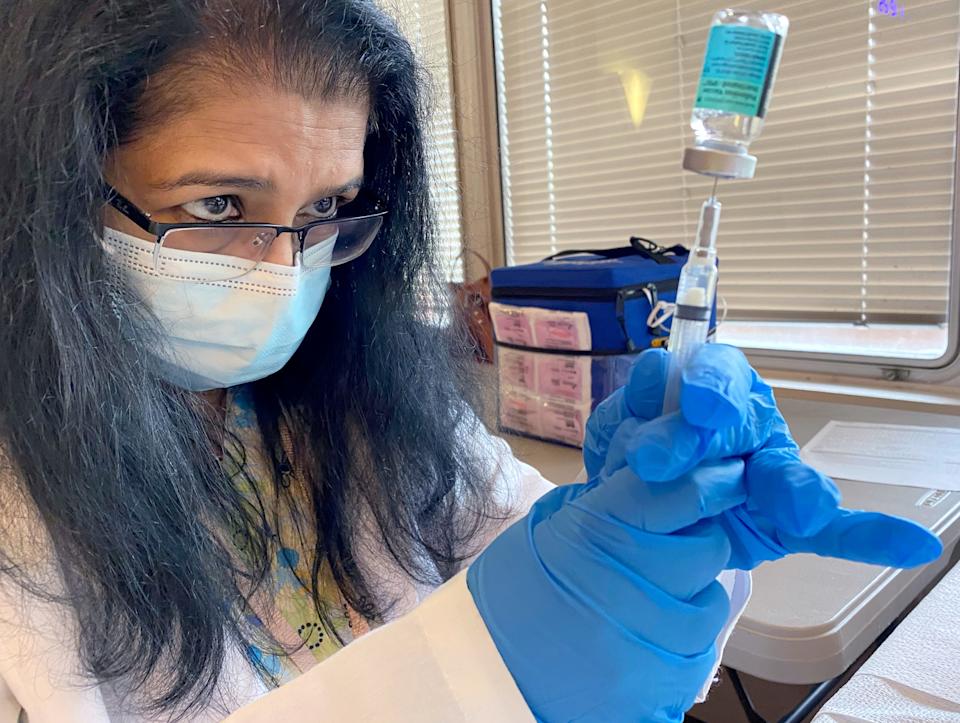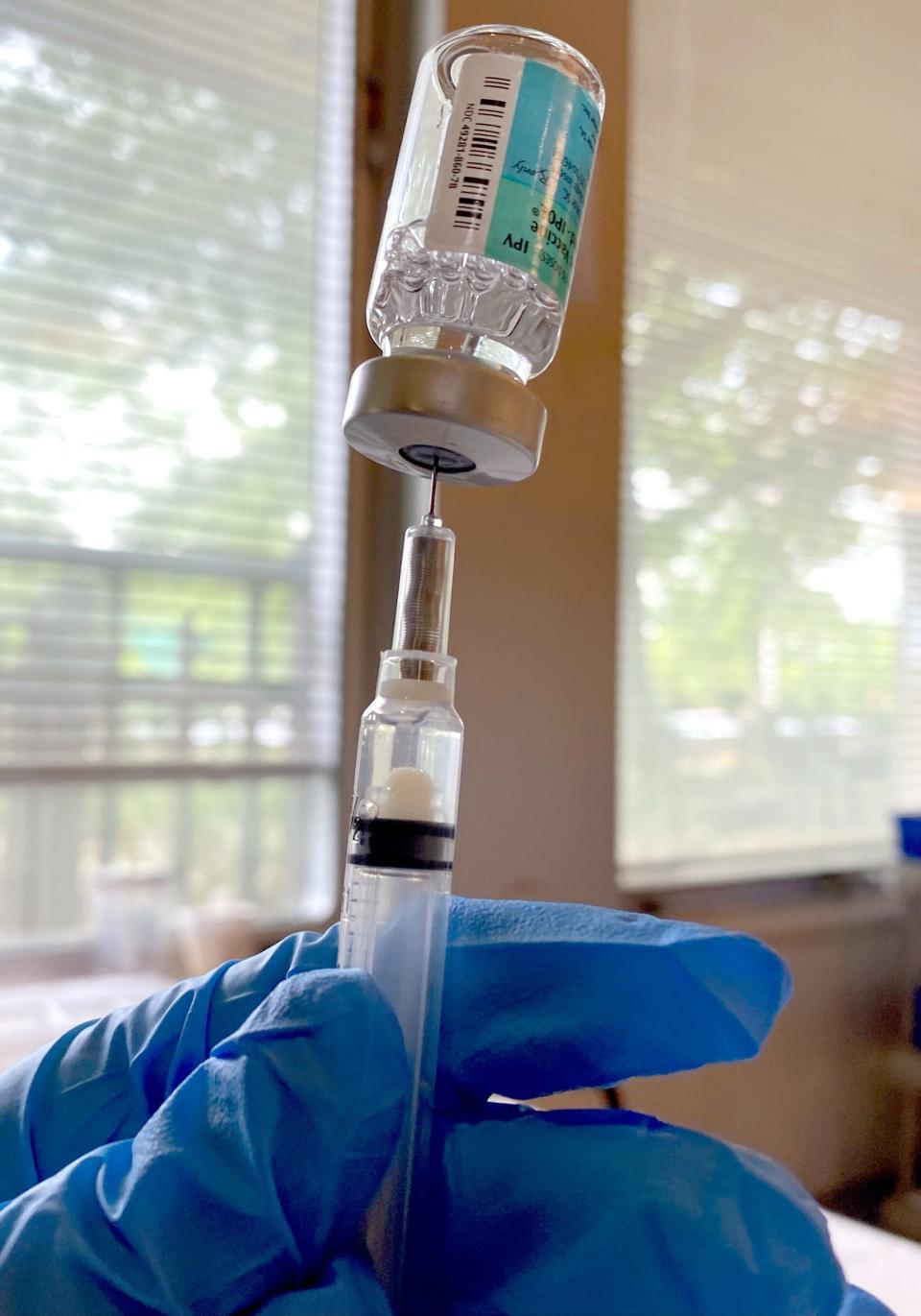What's the real risk from NY's polio outbreak?
As New York’s polio outbreak potentially spreads to hundreds of people, authorities are sounding alarms about the resurgent infectious disease that plagued past generations before being eradicated by vaccines decades ago.
For many New Yorkers − especially those born after the early 1950s when polio disabled more than 35,000 Americans per year prior to widespread vaccination − the health alerts raised sprawling questions about the once-feared virus that had been nearly forgotten.
Officials offered a public health crash course on everything from how polio spreads to who is at risk of being paralyzed due to infection. They also urged thousands of unvaccinated New Yorkers, including those in the outbreak epicenter in Rockland and Orange counties, to get shots and curb the virus’ spread.
“It’s tragic because it’s a completely preventable occurrence,” said Dr. William Schaffner, an Infectious Diseases Society of America expert, noting polio vaccines offer near complete protection against illness.
“That’s how vaccines work and that’s why we oblige vaccination, so these things don’t happen anymore,” added Schaffner, a Vanderbilt University Medical Center professor.
Against that backdrop, USA TODAY Network New York spoke to Schaffner and Dr. Kimberly Thompson, a polio expert and president of Kid Risk, Inc., about what people need to know about the reemergence of polio.
What follows are crucial facts about polio based on insights from Schaffner and Thompson, as well as analysis of state and federal public health information.
New York polio: 'Tip of the iceberg': How state health officials are setting off alarms over polio
Who is at risk from NY polio outbreak?
Polio poses a threat to anyone unvaccinated against the virus. It is a group that spans children too young to get the recommended four-dose vaccination series, as well as people of all ages who did not get vaccinated for a variety of reasons.
For example, about 1,140,000 New Yorkers are younger than 5. But the polio vaccine is most effective when kids get all four recommended doses, which are typically completed between the ages of 4 and 6. That means tens of thousands of the youngest kids in New York are currently endangered by the polio outbreak.
The polio vaccine has proven nearly 100% effective at preventing illness, which is why widespread vaccination campaigns led to U.S. health officials declaring it eradicated in 1979, despite rare cases imported by international travelers.
How many NY children are not vaccinated against polio?
In addition to the youngest children, some parents in New York have declined to get thousands of older children vaccinated against polio, despite state law requiring the shots for students at public and private school, excluding medical exemptions.
While only 2% of all schools statewide have polio vaccination rates below 90%, some schools lag behind.
The lagging schools include private and public schools from across the state, as well as several Orthodox Jewish communities in Rockland and Orange counties, which were central to debate over the repeal of the religious exemption to school vaccinations in 2019.
Check your district: Polio vaccinations lag at some schools
Since the religious exemption ended, many schools have pushed to boost vaccination rates among children previously claiming the exemption, a group of about 26,000 kids statewide, or 1% of school children in 2018.
The number of parents homeschooling children in New York has also increased since 2019, suggesting some of those religious exemption cases prompted parents to pull kids from classrooms to avoid vaccination.
About 54,400 school children were homeschooled last school year, a 65% increase from 33,000 kids homeschooled in the 2019-20 school year, state data show. And growing numbers of Americans joining the national anti-vaccination movement, according to national polling and legislative efforts, also potentially contributed to the rise in homeschooling, although COVID-19 mandates and concerns likely played a role as well.
Some counties in New York also lag behind the statewide vaccination rate for kids at age 2, which stands at about 79%. Rockland County, for example, has a 60% vaccination rate for the age group.
How does polio spread?

“The vast highway of polio transmission is via microscopic fecal matter,” Schaffner said, adding that fact explained why children with poor handwashing and hygiene were historically at heightened risk.
Generally, polio infects people who touch their mouth with feces-contaminated hands or objects, but a limited risk of spreading the virus still exists through droplets from a sneeze or cough, according to the Centers for Disease Control and Prevention.
Thompson noted polio posed a much lower threat of spreading through someone breathing, sneezing or coughing than COVID-19, but added some other principles hold true for many infectious diseases.
“The main thing about polio, and a lot of viruses, is that you’re most likely to get infected with somebody you’re in close contact with, such as family members,” she said.
Another risk factor involved people without polio symptoms, which are typically flu-like, who unknowingly spread the virus, regardless of vaccination status, Thompson noted. And that is why health officials have described the single Rockland case as the tip of the iceberg.
“We don’t know how widely this rogue virus has spread,” Schaffner said, addressing the Rockland case. “But back in the old days when there was a lot of wild polio, there was one case of paralytic disease for every 300-plus people who were infected,” he added.
Polio: Rockland County strain linked to Jerusalem and London
What are polio symptoms?

In general, most people infected with poliovirus, roughly about 72 out of 100, will not have any visible symptoms, the CDC said. And about one out of four people infected will have flu-like, including sore throat, fever and headache.
A smaller proportion of people − less than one out of 100, or one to five out of 1,000 − with poliovirus infection will develop other, more serious symptoms that affect the brain and spinal cord, including paralysis, the CDC noted.
Is there a treatment for polio?
In many ways, polio remains an incurable infectious disease despite decades of medical developments since vaccines all but eliminated the virus’ spread in the U.S.
“We’re treating polio the same way we did now as we did 40 years ago, however, our ventilators are better and we don’t use iron lungs,” Schaffner said, noting no antiviral treatments for polio exist.
For the people facing varying levels of polio paralysis, the treatment generally consists of rehabilitation to maximize functionality, he added. But, in many cases, the paralysis is permanent.
"That's another reason prevention is so important," Schaffner said.
Between two and 10 out of 100 people who have paralysis from poliovirus infection die, because the virus affects the muscles that help them breathe, CDC says.
Even children who seem to fully recover can develop new muscle pain, weakness, or paralysis as adults, 15 to 40 years later. That is called post-polio syndrome.
3 shots over 7 months: How to catch up on polio vaccination
What is a vaccine-derived poliovirus?
A vaccine-derived poliovirus is a strain related to the weakened live poliovirus contained in oral polio vaccine, CDC says.
The U.S. stopped using oral polio vaccine in 2000, citing the rare risk of vaccine-derived cases. It now exclusively uses inactivated poliovirus vaccine, which is given as an injection in the leg or arm.
But other countries continue to use the oral polio vaccine today, in part, due to the fact that the injectable vaccine is more costly and complex to administer. A global push is underway to transition all countries to the injectable polio vaccine.
Health officials said the polio case in Rockland County is connected to a traveler carrying vaccine-derived poliovirus, which can revert to a more dangerous form that causes illness and paralysis if allowed to circulate in a community with low vaccination rates.
Chris McKenna and Nancy Cutler of USA TODAY Network contributed to this report.
This article originally appeared on New York State Team: What's the real risk from New York's polio outbreak?

